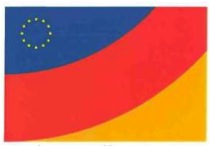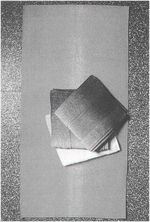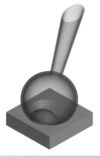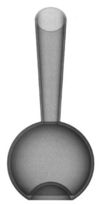Free initial assessment
Over 20 years of experience in design law
Thomas Seifried has over 20 years of experience in design law and has also been a specialised lawyer for intellectual property law since 2007. He is the author of specialist books and has conducted many successful proceedings before courts and public authorities.
+49669150760
You can send us your documents here. We will treat your enquiry as strictly confidential.
Our initial assessment of your case is free of charge.
Scope of examination of design applications
What EUIPO and DPMA only examine when registering designs

The DPMA and EUIPO only examine the application for a design to determine whether it is a "design" within the meaning of Section 1 I Design Act or a "design" within the meaning of Art. 3 a) CDR and whether it is contrary to public policy or morality or imitates national or intergovernmental signs.
Example: Due to imitation of the flag of the Council of Europe, which is also the flag of the European Union, the DPMA had refused registration of the following design (BPatG of 22 January 2015 - 30 W (pat) 703/13 - DE-Flagge):
EUIPO examines the quality of submitted images
The EUIPO examines whether the views (images) submitted with the application for a Community design are of sufficient quality (see Art. 4 I e) CDIR). Details must be visible on the submitted images of a design application.
The DPMA only stipulates that submitted JPEG files must have a resolution of at least 300 dpi (Sec. 7 V Design Ordinance).
EUIPO and DPMA do not examine novelty and individual character in the application
Offices do not examine protection requirements for designs and industrial designs
However, neither the DPMA nor the EUIPO examine the protection requirements of "novelty" and "individual character". Accordingly, the registration certificates of the German Patent and Trade Mark Office state:
"The protectability of the designs has not been examined by the German Patent and Trade Mark Office."
For this reason, registered designs are also registered quickly. At the EUIPO, applications can be registered within one day if the applicant maintains a permanent account with the EUIPO. A German registered design and a registered Community design is therefore an IP right that - unlike a patent (examined IP right) or a trademark (partially examined IP right) - is not examined by the offices.
Offices also do not examine grounds for refusal or infringements
The offices also do not examine whether the features of appearance of a design are determined solely by its technical function (Sec. 3 (1) No. 1 Design Act; Art. 8 (1) CDR) or must necessarily be copied in their exact function (Sec. 3 (1) No. 2 Design Act; Art. 8 (2) CDR). They certainly do not examine whether the use of a design applied for would infringe older registered designs or Community designs. Whether the owner of a registered design or a registered Community design can also derive rights from the registration must therefore be proven anew in each case of infringement. Whether the use of a design infringes a German registered design or a registered Community design therefore initially depends on whether the design was "new" and had "individual character" at the time of application. If it was, it depends on whether the potentially infringing design does not create a different overall impression on the "informed user".
Many registered designs are actually not protectable
Since the offices hardly ever examine designs and Community designs when they are applied for, you will find entries in the registers that are obviously worthless. The costs, fees and time spent on the application could have been saved. Two typical errors are made time and again: the applicant is mistaken about the protectability of letters and words or he is mistaken about the meaning of the product indication. Particularly unforgivable are errors in the illustrations of the product to be protected. Here, several different products are often filed in a single application (not a multiple application). Such applications are absolutely worthless because the scope of protection cannot be determined:
Principle: The scope of protection must be recognisable from the illustrations
It is not the product itself (e.g. terry towel) that is protected as a design, but only its appearance, i.e. the state reproduced in the illustration. Only what is recognisable in the application is protected (cf. § 37 I DesignG). The protection of the design depends on which specific form can be recognised from the illustration (see BGH of 24 March 2011 - I ZR 211/08 - Schreibgeräte; BGH of 22 April 2010 - I ZR 89/08 - Verlängerte Limousinen). What cannot be recognised from the submitted photos or drawings is not protected.
Typical errors when filing design applications: filing several products in one application
Example 1: A pile of terry towels

The picture shows a now expired German design registration (today: registered design) for terry towels. The black and white background shows four obviously coloured terry towels. Three of the terry towels are folded on top of each other on a fourth terry towel spread out. Several mistakes have been made here:
Error 1: Black and white illustration of the design
The colour and the surface structure are essential features that determine the appearance of a product (see § 1 DesignG). Coloured designs should therefore always be submitted in colour. Exception: Protection independent of colour is sought with an abstract representation. However, such an abstract representation was not submitted here, but a black and white photo. However, protection for colours cannot be derived from a black and white submission.
Error 2: Not one product or part of a product, but several
A design (§ 1 No. 1 DesignG) or design patent (Art. 3 a GVV) is the appearance of an entire product or a part thereof. In fact, not one product is depicted here, but actually four products. It is true that a product can also consist of several elements as a so-called "combination product". Prerequisite: The individual elements are recognisable as elements of a whole (ECJ of 25 October 2013 - T 231/10 Merlin et al. v Dusyma Kindergartenbedarf GmbH).
Here it is quickly clear that the applicant did not want to protect a bundle of terry towels, but several different coloured terry towels in one image. The applicant may have misunderstood the term "multiple application". In a multiple application, up to 100 independent designs can be summarised in one application to save costs, § 12 DesignG. Legally, however, all designs in a multiple application are independent property rights. Such an illustration therefore does not constitute a design within the meaning of the law because several independent products are actually reproduced in one illustration.
Example 2: Several different sports helmets - BGH of 20 December 2018 - I ZB 25/18 - Sports helmet




The case: The illustrations shown above were filed with the German Patent and Trade Mark Office for the design 402008001032-0001. These show different helmets for one and the same individual application. The helmets differ in the basic colour, the decoration and the straps (with and without ear flaps). Some of the helmets contain a "rider button". An application for cancellation to the DPMA was filed on the grounds that this was not in fact "one" design with a single scope of protection. Rather, it was a matter of several designs. A uniform scope of protection could therefore not be established. It was not possible to determine which features should be protected and which should not. However, the Federal Patent Court refused to declare the design invalid. There was an "intersection" of matching features: In any case, all helmets have an identically shaped helmet shell in common.
According to the law (§ 1 No. 1 DesignG), a design is the appearance of "a" product. A design that reproduces several representations of different products in the application is invalid (cf. Section 33 I No. 1 DesignG). However, previous case law has been more generous in these cases. In the "Sitz-Liegemöbel" decision (BGH of 15 February 2001 - I ZR 333/98 - Sitz-Liegemöbel), the BGH still assumed that an intersection of the matching features could be formed in the case of several representations with different designs. This was then the scope of protection. The BGH has abandoned this case law. A design can only ever have uniform protection. The scope of protection must result directly from the representations in the register. However, an intersection of the features common to all representations would only exist in the mind of the observer. This is not compatible with legal certainty. A uniform protection for the representations of different helmets could not be determined. The BGH referred the case back to the Federal Patent Court. This court must now declare the design invalid.
Typical error in a design application: Contradictory representation
BGH, judgement of 08.03.2012 - I ZR 124/10 - Wine carafe


Contradictory representations of the product can completely invalidate design protection. An example from case law: The defendant was the owner of the Community design 000383757-0001. She had registered the design partly with a base and partly without a base (see above).

The defendant sold the depicted wine carafe without a base. The BGH had denied a design infringement: Since the registration was contradictory (once with and once without a base), the scope of protection had to be interpreted. Such an interpretation would mean that the carafe with a base was protected. The illustrations without a base merely clarified the design of the carafe. The overall impression is always decisive for the scope of protection. The respective elements (carafe and base) were not protectable in isolation. Neither Community design law nor German design law would permit protection of elements. Protection of the isolated elements could easily be obtained through an isolated registration (Art. 3 a Community Design Regulation or § 1 No. 1 DesignG).
Registration of "combination products": BGH of 24 March 2022 - I ZR 16/22 - Cutting board
Ineffective multiple product or effective combination product? The significance of the product indication when applying for designs
A design that reproduces different designs in several representations in the application is invalid (see Section 33 I No. 1 DesignG). In the "Sitz-Liegemöbel" decision (BGH of 15 February 2001 - I ZR 333/98 - Sitz-Liegemöbel), the BGH still assumed that an intersection of the matching features could be formed in the case of several representations with different designs. The BGH abandoned this case law in the "Sporthelme" decision (BGH of 20 December 2018 - I ZB 25/18 - Sporthelm, see above): A design can only ever have uniform protection. The scope of protection must result directly from the representations in the register. An intersection of the features common to all representations would only exist in the mind of the observer. This is not compatible with legal certainty.
Protection of individual elements
It is also possible to protect an isolated part of a product (e.g. a shoe sole) (Art. 3 a Community Design Regulation or § 1 No. 1 Design Act). However, this presupposes that this part of the product is also registered in isolation as a design, as is the case, for example, with this shoe sole registered as a design (see BGH of 23 February 2012 - I ZR 68/11 - Milla):

It is not possible to protect different product elements in a single application.
Protection of "combination products"
However, a product often consists of different elements. Protection of such products is possible as a "combination product" in a single application. The entire product including its elements is then protected. This is because the illustrations of the elements must not contradict each other, even when applying for a combined product. The devil is in the detail here, as the following example shows:




At first glance, this is a classic combination product. It is clear that these ski goggles consist of several separable elements. A pair of ski goggles that can be disassembled into individual parts (and not the isolated individual parts) would be protected.
On closer inspection, however, the submitted illustrations show several incompatible features: The goggle strap and goggle frame show a different colour contrast in the illustrations. While the spectacle band and frame are shown dark at the top and light at the bottom in Figure 1, the colour contrast is reversed in Figure 2. In addition, the decorative surfaces above the lenses in the illustrations differ in shape, colour, contrast and size. This led to the invalidity of the design (BGH, decision of 20 December 2018 - I ZB 26/18 - Sportbrille).
Interpretation of a design application with different images of different products
The "cutting board" case now to be decided by the Federal Court of Justice (BGH of 24 March 2022 - I ZR 16/22 - Schneidebrett ) was not so clear-cut. In this case, the owner of the design with the above depictions of a cutting board had filed a lawsuit. He had specified "cutting boards" as the product in the design application. He considered a similar cutting board to be an infringement of his registered design with the three illustrations. The owner of the design brought an action against the supplier of the imitation. The latter defended himself with a counterclaim in which he sought a declaration that the design in suit was invalid. His argument: The first illustration shows a cutting board with a drip tray (the fruit and vegetables also shown are obviously only accessories). In the other two illustrations, the cutting board is shown without a drip tray. The design therefore does not show "one" product, but two. A combination product cannot be inferred either. It is not recognisable whether the cutting board contains milled grooves to guide the drip tray. It was therefore not possible to recognise beyond doubt that the drip tray was aesthetically and functionally matched to the cutting board (which would argue in favour of a combination product). It was therefore not possible to recognise what was to be protected: A cutting board without a drip tray or a cutting board with a drip tray. For this reason, the Court of Appeal declared the design invalid. The BGH did not see it that simply: The cutting board shown in the second and third illustration was also included in the first illustration. The drip tray was also functionally coordinated with the cutting board. This is because the cutting waste can be pushed into it from the cutting board. A constructive connection, for example by means of milled recesses to guide the cutting board, is not necessary for a functional connection. It is also not necessary for two elements to belong together aesthetically and functionally. It is sufficient if they are recognisably related, i.e. aesthetically or functionally coordinated.
Product specification relevant for the interpretation
The Federal Court of Justice therefore returned the case to the Court of Appeal. It must now interpret the design application once again. In its interpretation, it must also consider the product indication. This reads "cutting boards". According to the instructions of the BGH, it must take into account that, on the one hand, the drip tray belongs functionally together with the cutting board, which would argue in favour of protection as a combined product consisting of a cutting board and a drip tray. On the other hand, the product description in the application only reads "cutting boards" (and not "cutting boards with drip trays"). If it cannot be determined by interpretation whether only the cutting board or the cutting board together with the drip tray should be protected, the Court of Appeal must repeat its decision and declare the design invalid.
Protectability of letters and words
Only shape, not meaning, can be protected as a design
[Registered designs or registered community designs often contain letters or words. However, the conceptual meaning of letters and words is not covered by design protection (see BPatG of 13 February 2014 - 30 W (pat) 701/13 - NOR DER NEY). It only depends on the design of the typeface. However, this usually lacks novelty or individual character.
Example: T-shirt with "POLICE" printed on it
The now expired design (today: registered design) from the DPMA register shows an abstract representation of a T-shirt with a print. The content of the lettering ("Police") is irrelevant under design law. This is because the conceptual meaning of letters and words is not covered by design protection (see BPatG of 13 February 2014 - 30 W (pat) 701/13 - NOR DER NEY). It only depends on the design of the font. Therefore, it is not a white T-shirt with black lettering "Police" that is protected, but a T-shirt with an ordinary sans serif font. However, T-shirts printed in a sans serif font had long been known at the time of filing in 1993. The design was therefore neither "new" nor did it have any "individual character". So nothing was actually protected here.
Tips for registering designs
When applying for registration as a Community design, up to seven different views of the design can be submitted. The German Design Regulation even allows up to ten views per representation when applying for a German design (Section 7 III 3 DesignV). Take advantage of the opportunity to show the individual character, i.e. the distinctiveness from other designs, in several illustrations. What makes the design unique must be clear from the illustrations. In the case of three-dimensional products, it is advisable to submit illustrations of the product from all relevant perspectives. It is essential that the illustrations relate to one and the same model.
If you want to protect a combination product both as a whole and in its individual parts, you must file separate applications for both the overall product and the individual parts. This can be done cost-effectively in a multiple application.
The application in "abstract representation"
Colour-neutral protection for black and white drawings
![[Translate to English:] Beispiel: Abstrahiert eingetragenes Gemeinschaftsgeschmacksmuster 000916325-0006](/fileadmin/_processed_/b/9/csm_Wiedergabe_2_7aa96a2ec0.jpg)
In the case of registered Community designs and registered designs, certain methods of representation have become established, with the help of which the applicant indicates that he wishes to limit or extend the scope of protection of the respective property right. A design or Community design applied for in "abstract representation" generally claims colour-independent protection for the deposited design. Such designs are usually represented in a black-and-white graphic or a black-and-white photograph. The design is "abstracted" from the colours, so to speak. However, only a uniform colour scheme is protected here (BGH of 24.03.2011 - I ZR 211/08 - Schreibgeräte). An abstract registered design therefore initially extends the scope of protection (BGH of 20 December 2018 - I ZB 26/18 - Sportbrille). This is because it indicates that the design is to be protected regardless of colour. However, this only applies to uniform colourings. If the contested design does not use a uniform colour scheme at all but, for example, contrasting colours, this can lead to a different overall impression (BGH - Schreibgeräte - loc. cit.; OLG Frankfurt v. 25.02.2013 - 6 U 11/13 - Farbneutrale Damenhandtasche). The same applies if the overall impression of the disputed design is characterised by the colour design.
Trade fair certificate: Bringing forward the date of application
Anyone who applies to register a design that they have previously exhibited at a trade fair and tested for marketability there can claim "exhibition priority" (Section 15 Design Act). The same applies to the application for registration of a trademark if the marked product was previously exhibited (see Section 35 MarkenG). This means that the filing date, which marks the start of protection upon registration, is brought forward to the date of the exhibition. Prerequisite: The applicant applies for registration of the design within six months of the first exhibition. The day of the first exhibition then counts as the filing date.
However, trade fair certificates are only accepted from certain trade fairs. For applications for German designs or trademarks at the German Patent and Trade Mark Office - DPMA, these are the trade fairs that are published in advance in a notice in the Federal Law Gazette. For example, the following trade fairs are listed in the Federal Law Gazette (BAnz AT 26.10.2020 B1 or BAnz AT 19.11.2020 B2):
"iENA - International Trade Fair Ideas-Inventions-New Products"
from 29 October to 1 November 2020 in Nuremberg
"EUROBIKE - 29th International Bicycle Trade Fair"
from 24 to 26 November 2020 in Friedrichshafen
"opti - The international trade fair for optics & design"
from 8 to 10 January 2021 in Stuttgart
"LogiMAT 2021 - International Trade Fair for Intralogistics Solutions and Process Management"
from 22 to 24 June 2021 in Stuttgart
"INTERNATIONAL TRADE FAIR - Your meeting place for the skilled trades."
from 10 to 14 March 2021 in Munich
"iba 2021 - The leading world trade fair for bakery, confectionery and snacks"
from 24 to 28 October 2021 in Munich
"sps connect - The digital automation hub"
from 24 to 26 November 2020 - Virtual
"CMM - Connected mobile Machines & Mobility"
from 1 to 2 December 2020 in Hanover
"139th German Young Poultry Show Hanover 2020"
from 18 to 20 December 2020 in Hanover
The EUIPO currently only recognises world exhibitions as establishing a priority. The exhibition priority is therefore practically irrelevant for the application of an EU trademark or a Community design. A national design or a national trademark can also be subsequently applied for as a Community design or EU trademark within six months. As the EUIPO only checks the date of the national application, but no longer checks where the national priority comes from (see OAMI Newsletter 02-2009), it may ultimately be possible to obtain a Community design or EU trademark with national exhibition priority via the diversions of the national application. WIPO in Geneva does not check the national priorities either. Irrespective of this, protection from the unregistered Community design arises from the exhibition at a trade fair.
At Frankfurt trade fairs, trade fair certificates are issued at the "Messe Frankfurt against Copying" information stand. The stand is usually located in the foyer of Hall 4.1.
Author: Thomas Seifried, Lawyer for design law and specialist lawyer for intellectual property law
Example of our successes in design law:
Is the distribution of the ladies' jacket on the right an infringement of the unregistered Community design on the left? LG Düsseldorf, Urteil vom 27.2.2018 – 14c O 133/17
Infringement of a terry towel design by a pharmacist - Right to information in injunction proceedings - OLG Frankfurt v. 11.5.2017 - 6 U 242/16


